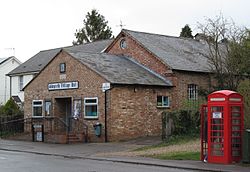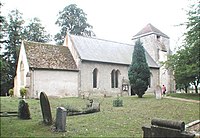Shepreth
| Shepreth | |
| Cambridgeshire | |
|---|---|
 Shepreth Village Hall and Book Exchange (the red telephone box) | |
| Location | |
| Grid reference: | TL3947 |
| Location: | 52°6’44"N, -0°1’57"E |
| Data | |
| Population: | 819 (2001) |
| Post town: | Royston |
| Postcode: | SG8 |
| Dialling code: | 01763 |
| Local Government | |
| Council: | South Cambridgeshire |
Shepreth is a village in Cambridgeshire, lying halfway between Cambridge and Royston in the south of the county.
Listed as Esceprid in the Domesday Book the name "Shepreth" is the Old English ‘’Sceap riþ’’, which means "sheep stream", and was used as a resting place where sheep could be washed on their route to Cambridge. The Sheep Bridge was still in use in 1626.[1][2]
Churches

The parish church of All Saints is an ancient edifice of brick and flint in the Early English style, consisting of nave and a low western tower containing two bells. The chancel arch dates from the early 12th century.[3] There are some monuments to the Layer family (who formerly possessed property here) dated 1730, 1743 and 1760.
There is also a 13th Century octagonal font[3] of Barnack stone, and an old oak treasure chest which was unearthed about 1895. The grade II* listed church was restored in 1870, and affords 120 sittings. The register dates from the year 1569.
There is a Congregational chapel, erected in 1901 and seating 120 congregants.
A stone cross was erected on Pretty Corner in 1920, in memory of the men from the parish who fell in the Great War.
History
The parish of Shepreth is roughly-rectangular and covers 1,318 acres. It is bounded by the River Cam to the north, which separates it from Barrington, Foxton brook to the east, across which lies Foxton, and Melbourn brook to the west, separating it from Meldreth and Melbourn. The field boundaries to the south border the parish of Fowlmere.[1]
Stone Age weapons and tools have been found in the parish, and the land, formerly marshy, could thus have housed a lakeside settlement. Evidence of Roman habitation has been found on the drier ground in the northeast corner of the parish.[1][4] Two mediæval moated sites in the village are scheduled as ancient monuments.[5][6]
Village life
The village has had its own station since 1851. Shepreth railway station is on the East Coast Main Line|Great Northern Line, the main line between Cambridge and London.
The parish contains a wildlife park, a nature reserve, Shepreth L-Moor, and one of the the United Kingdom’s only insect research laboratories.
Shepreth now has two public houses, The Green Man at Frog End on the Cambridge to Royston road, and the Plough on the High Street. In the 18th century The Green Man was known as the Bottle and Anchor. The pub which is now known as The Plough burnt down and was rebuilt in 1896. The Railway Tavern by the station opened in 1873 and closed in around 1960.[1]
Pictures
-
Capybara in Shepreth Wildlife Park
-
Mandarin Duck in Shepreth Wildlife Park
Outside links
| ("Wikimedia Commons" has material about Shepreth) |
References
- ↑ 1.0 1.1 1.2 1.3 A History of the County of Cambridge and the Isle of Ely, Volume 5
- ↑ A. D. Mills (2003). "A Dictionary of British Place-Names". http://www.encyclopedia.com/doc/1O40-Shepreth.html.
- ↑ 3.0 3.1 National Heritage List 1330821: All Saints, Shepreth
- ↑ National Heritage List 1006873: Roman site N of Brown Spinney
- ↑ National Heritage List 1019549: Shepreth
- ↑ National Heritage List 1019182: Shepreth


